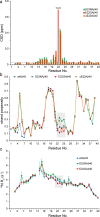Familial Alzheimer's Disease-Related Mutations Differentially Alter Stability of Amyloid-Beta Aggregates
- PMID: 36734539
- PMCID: PMC9940190
- DOI: 10.1021/acs.jpclett.2c03729
Familial Alzheimer's Disease-Related Mutations Differentially Alter Stability of Amyloid-Beta Aggregates
Abstract
Amyloid-beta (Aβ) deposition as senile plaques is a pathological hallmark of Alzheimer's disease (AD). AD is characterized by a large level of heterogeneity in amyloid pathology, whose molecular origin is poorly understood. Here, we employ NMR spectroscopy and MD simulation at ambient and high pressures and investigate how AD-related mutations in Aβ peptide influence the stability of Aβ aggregates. The pressure-induced monomer dissociation from Aβ aggregates monitored by NMR demonstrated that the Iowa (D23N), Arctic (E22G), and Osaka (ΔE22) mutations altered the pressure stability of Aβ40 aggregates in distinct manners. While the NMR data of monomeric Aβ40 showed only small localized effects of mutations, the MD simulation of mutated Aβ fibrils revealed their distinct susceptibility to elevated pressure. Our data propose a structural basis for the distinct stability of various Aβ fibrils and highlights "stability" as a molecular property potentially contributing to the large heterogeneity of amyloid pathology in AD.
Conflict of interest statement
The authors declare no competing financial interest.
Figures




Similar articles
-
Familial Alzheimer's disease mutations at position 22 of the amyloid β-peptide sequence differentially affect synaptic loss, tau phosphorylation and neuronal cell death in an ex vivo system.PLoS One. 2020 Sep 23;15(9):e0239584. doi: 10.1371/journal.pone.0239584. eCollection 2020. PLoS One. 2020. PMID: 32966331 Free PMC article.
-
E22G Aβ40 fibril structure and kinetics illuminate how Aβ40 rather than Aβ42 triggers familial Alzheimer's.Nat Commun. 2024 Aug 15;15(1):7045. doi: 10.1038/s41467-024-51294-w. Nat Commun. 2024. PMID: 39147751 Free PMC article.
-
Familial Alzheimer's disease Osaka mutant (ΔE22) β-barrels suggest an explanation for the different Aβ1-40/42 preferred conformational states observed by experiment.J Phys Chem B. 2013 Oct 3;117(39):11518-29. doi: 10.1021/jp405389n. Epub 2013 Sep 13. J Phys Chem B. 2013. PMID: 24000923 Free PMC article.
-
Perspective for Molecular Dynamics Simulation Studies of Amyloid-β Aggregates.J Phys Chem B. 2023 Dec 28;127(51):10931-10940. doi: 10.1021/acs.jpcb.3c06051. Epub 2023 Dec 18. J Phys Chem B. 2023. PMID: 38109338 Review.
-
Alzheimer's disease.Subcell Biochem. 2012;65:329-52. doi: 10.1007/978-94-007-5416-4_14. Subcell Biochem. 2012. PMID: 23225010 Review.
Cited by
-
Bifurcations in coupled amyloid-β aggregation-inflammation systems.NPJ Syst Biol Appl. 2024 Jul 30;10(1):80. doi: 10.1038/s41540-024-00408-7. NPJ Syst Biol Appl. 2024. PMID: 39080352 Free PMC article.
-
AlzDiscovery: A computational tool to identify Alzheimer's disease-causing missense mutations using protein structure information.Protein Sci. 2024 Oct;33(10):e5147. doi: 10.1002/pro.5147. Protein Sci. 2024. PMID: 39276018 Free PMC article.
-
Clay-Polymer Nanocomposites Mediated Inhibition of Protein Aggregation: Possible Role in the Prevention of Proteinopathies.Protein Pept Lett. 2025;32(2):139-151. doi: 10.2174/0109298665274059231002071951. Protein Pept Lett. 2025. PMID: 37855298
-
Survey of the Aβ-peptide structural diversity: molecular dynamics approaches.Biophys Rev. 2024 Nov 20;16(6):701-722. doi: 10.1007/s12551-024-01253-y. eCollection 2024 Dec. Biophys Rev. 2024. PMID: 39830132 Review.
-
Computational Study of Amyloidβ42 Familial Mutations and Metal Interaction: Impact on Monomers and Aggregates Dynamical Behaviors.Inorg Chem. 2024 Mar 11;63(10):4725-4737. doi: 10.1021/acs.inorgchem.3c04555. Epub 2024 Feb 26. Inorg Chem. 2024. PMID: 38408469 Free PMC article.
References
-
- World Health Organization. Dementia; https://www.who.int/en/news-room/fact-sheets/detail/dementia (accessed Jan. 21, 2023).
-
- Ryman D. C.; Acosta-Baena N.; Aisen P. S.; Bird T.; Danek A.; Fox N. C.; Goate A.; Frommelt P.; Ghetti B.; Langbaum J. B.; Lopera F.; Martins R.; Masters C. L.; Mayeux R. P.; McDade E.; Moreno S.; Reiman E. M.; Ringman J. M.; Salloway S.; Schofield P. R.; Sperling R.; Tariot P. N.; Xiong C.; Morris J. C.; Bateman R. J.; Symptom onset in autosomal dominant Alzheimer disease: a systematic review and meta-analysis. Neurology 2014, 83, 253–260. 10.1212/WNL.0000000000000596. - DOI - PMC - PubMed
MeSH terms
Substances
LinkOut - more resources
Full Text Sources
Medical

